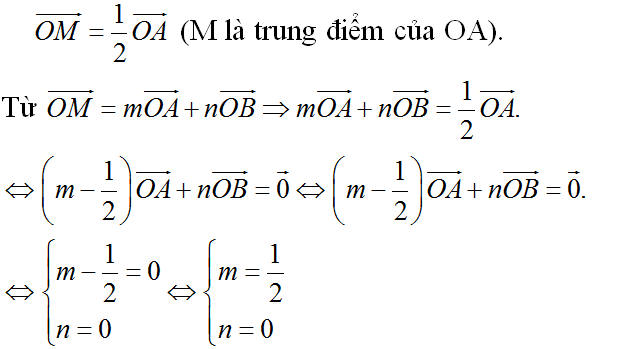Hãy nhập câu hỏi của bạn vào đây, nếu là tài khoản VIP, bạn sẽ được ưu tiên trả lời.

b)
O B A M N
\(\overrightarrow{AN}=\dfrac{1}{2}\overrightarrow{AO}=-\dfrac{1}{2}\overrightarrow{OA}\)
Vậy \(m=-\dfrac{1}{2};n=0\).
c)
\(\overrightarrow{MN}=\dfrac{1}{2}\overrightarrow{AB}=\dfrac{1}{2}\left(\overrightarrow{AO}+\overrightarrow{OB}\right)=-\dfrac{1}{2}\overrightarrow{OA}+\dfrac{1}{2}\overrightarrow{OB}\).
Vậy \(m=-\dfrac{1}{2};n=\dfrac{1}{2}\).
d)
\(\overrightarrow{MB}=\dfrac{1}{2}\overrightarrow{OB}\)
Vậy \(m=0;n=\dfrac{1}{2}\).

A B C P M N
a) \(\overrightarrow{PM}=\overrightarrow{PB}+\overrightarrow{BM}=\frac{1}{2}\overrightarrow{AB}+2\left(\overrightarrow{AC}-\overrightarrow{AB}\right)=2\overrightarrow{AC}-\frac{3}{2}\overrightarrow{AB}\)
Do \(\overrightarrow{NA}+2\overrightarrow{NC}=\overrightarrow{0}\)nên N thuộc đoạn AC và \(\overrightarrow{AN}=\frac{2}{3}\overrightarrow{AC}\)
\(\overrightarrow{PN}=\overrightarrow{PA}+\overrightarrow{AN}=-\frac{1}{2}\overrightarrow{AB}+\frac{2}{3}\overrightarrow{AC}=\frac{2}{3}\overrightarrow{AC}-\frac{1}{2}\overrightarrow{AB}\)
b) Ta thấy \(\overrightarrow{PN}=\frac{1}{3}\left(2\overrightarrow{AC}-\frac{3}{2}\overrightarrow{AB}\right)=\frac{1}{3}\overrightarrow{PM}\). Suy ra M,N,P thẳng hàng (đpcm).

Câu 1:
\(AC=\sqrt{AB^2+BC^2}=\sqrt{2}\)
\(\Rightarrow\overrightarrow{AB}.\overrightarrow{AC}=AB.AC.cos45^0=1.\sqrt{2}.\frac{\sqrt{2}}{2}=1\)
Đáp án D sai
Câu 2:
\(BN=\frac{1}{2}BM=\frac{1}{4}BC\Rightarrow4\overrightarrow{BN}=\overrightarrow{BC}\)
Ta có:
\(4\overrightarrow{AN}=4\left(\overrightarrow{AB}+\overrightarrow{BN}\right)=4\overrightarrow{AB}+4\overrightarrow{BN}=4\overrightarrow{AB}+\overrightarrow{BC}\)
\(=4\overrightarrow{AB}+\overrightarrow{BA}+\overrightarrow{AC}=4\overrightarrow{AB}-\overrightarrow{AB}+\overrightarrow{AC}=3\overrightarrow{AB}+\overrightarrow{AC}\)
Đáp án A đúng

Bài 1. Ta có: \(a\left(a+2\right)\left(a-1\right)^2\ge0\therefore\frac{1}{4a^2-2a+1}\ge\frac{1}{a^4+a^2+1}\)
Thiết lập tương tự 2 BĐT còn lại và cộng theo vế rồi dùng Vasc (https://olm.vn/hoi-dap/detail/255345443802.html)
Bài 5: Bất đẳng thức này đúng với mọi a, b, c là các số thực. Chứng minh:
Quy đồng và chú ý các mẫu thức đều không âm, ta cần chứng minh:
\(\frac{1}{2}\left(a^2+b^2+c^2-ab-bc-ca\right)\Sigma\left[\left(a^2+b^2\right)+2c^2\right]\left(a-b\right)^2\ge0\)
Đây là điều hiển nhiên.

Chọn A.
Ta có: